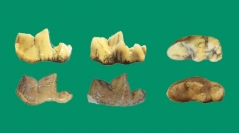

 Comptes Rendus Palevol
22 (3) - Pages 33-44
Comptes Rendus Palevol
22 (3) - Pages 33-44The present paper deals with the ecomorphological characteristics of two sympatric species of ictitheres: Ictitherium viverrinum Roth & Wagner, 1854 and Hyaenictitherium wongii (Zdansky, 1924) from the Late Miocene of the Eastern Mediterranean. These two species represent different taxonomic groups with allegedly distinct ecological roles. The values of 11 ecomorphological proxies were calculated using cranial and dental elements, in order to make an extensive comparison between them (body mass, bite force, canines’ and incisors’ bending strength, endocranial volume, relative rostral width, dental mesowear, intercuspid notches and carnassial vs grinding surfaces). The proxies show similar results for both species, pointing out that they had a similar ecological niche in the Late Miocene ecosystems. Carnivorans are usually in the top of the food chain, so the existence of two ecologically similar species in the same spatiotemporal range results in interspecific competition. This explains the geographical distinction of the two species with several localities being dominated by only one of the two (e.g. Samos for Hyaenictitherium Kretzoi, 1938 and Pikermi for Ictitherium Wagner, 1848). The reason for the prevalence of each genus can be associated with their postcranial morphology, as Hyaenictitherium has been proposed to be better adapted to chase hunting, because of its longer limbs, while Ictitherium is characterized by shorter and stouter limbs.
Hyaenidae, Ictitherium, Hyaenictitherium, Turolian, Greece